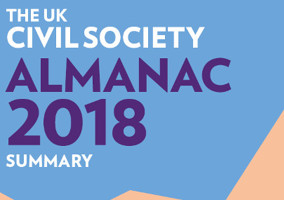The latest edition of the UK Civil Society Almanac, published today by NCVO, shows a sector growing fast. David Ainsworth looks at the key findings.
The UK Civil Society Almanac is the gold standard of charity data. It’s a fantastic resource which measures every detail of the sector.
The almanac looks at what it calls "general charities" which excludes a lot of the biggest bodies on the Charity Commission register - universities, housing associations, independent schools, and some quangos. But it's UK wide so it includes Scottish and Northern Irish charities.
It’s based on a detailed analysis of filed accounts so it's well behind the curve. It covers the period to March 2016, so it's worth remembering that we're pre-referendum here.
Let's pull out some trends from the document.
Key findings
The almanac shows there are 166,000 charities, with 881,000 employees, turning over £47.8bn. Income is up 4 per cent on last year, in real terms. This is the latest in a few years of above-inflation increases. So after a sluggish few years, the sector is once again growing.
This returns to a long-term trend. Since the turn of the century, charities have grown by roughly 50 per cent in real terms, compared to a 29 per cent growth in GDP.
The sector is also a London industry. Almost half of all income accrues to charities based in London, although it is worth saying that this does not mean it is spent in the capital. Many big charities have head offices in London but spend their money elsewhere in the UK and abroad.
What's happening to government income?
Historically a lot of the sector's growth has come from government income, which shot up in the last decade and has since held reasonably steady, despite swingeing cuts to state spending.
What is curious is that government grant income rose by 20 per cent in a year, after a long period of decline, while contract income fell. This is a reverse of recent trends, and pushes grant funding back up towards the peaks of the last decade.
It turns out however that this is down to a change in measurement. Charities, it seems, may increasingly be accounting for grants not as voluntary income but as "income from charitable activities". In other words, grant giving is increasingly seen as payment for services rendered.
What about income from individuals?
Individuals remain the sector’s biggest source of income, but the mixture is changing.
Over the last 15 years, income from voluntary sources seems to have risen by about two thirds, which is reasonably good - double GDP growth. I’m slightly suspicious of this, because household giving surveys show a rise in line with GDP. The difference may well be down to legacies and major giving, which are based on wealth, not income. House prices and share prices have both roughly tripled compared to GDP in the past three decades.
Meanwhile earned income has more than doubled, and is up again this year, by 7 per cent. This is money from the sale of charitable services and from trading and fundraising events.
Total income from voluntary sources – donations and legacies – is now £10.9bn, which seems comparable to earned income of £11.4bn, but this is misleading. Delivering this income still costs a lot more than fundraising for voluntary income, although fundraising ROIs are falling, so this gap is closing.
The almanac gives a fundraising ratio of £4.20, which is still good, but I’d be interested to see how that changes. Big charities are using lower ROI techniques and the cost of fundraising is rising as a result.
Big charities
There's another really strong narrative in this issue of the almanac, which is the growth in big charities. There is an idea in the sector that there is a “squeezed middle” of small-to-medium charities who are struggling, while the big boys hoover up more and more income.
I actually believe in this narrative. It chimes with what we see. But I think we must take care with the data that we use to track it.
The almanac highlights the growth of a new “super-major” charity class - those with incomes over £100m - who are growing in number.
But this would be happening even if there were no squeezed middle. If we leave income bands in the same place, inflation and GDP growth will naturally push more and more charities into larger categories.
Our own haysmacintyre / Charity Finance 100 Index tracks the same number of charities over time. The top 100 charities have grown by 144 per cent between Mar 2001 and Mar 2017, or 58 per cent when adjusted for inflation, which indicates there’s some truth in the idea that the biggest charities are racing away.
But the 100 Index has its own caveats. It includes independent schools, for a start, which the almanac excludes. It doesn’t take into account the impact of some very large mergers. And it doesn’t correct for the government's recent habit of transferring very big quangos into the sector. There is also the problem of accounting changes, which have largely shifted the investment returns of vast grantmakers off the bottom line.
Workforce
Finally, the almanac shows a changing workforce. The sector's pool of labour is getting more male and more full time. The sector is obviously changing as it grows.
Where the sector is performing very poorly is on racial equality. A compelling statistic is that only 9 per cent of the sector is BAME. Especially if half the sector is in London - and it is - because 38 per cent of the population in the capital is black, asian, arab or mixed, according to the 2011 census.
The sector seems to have a fairly serious problem with race. One recent writer on our site suggested that when it comes to disability, we’re also performing poorly compared to other sectors. So my final challenge, really, is that that is an area where we need to do much better.
Related articles










